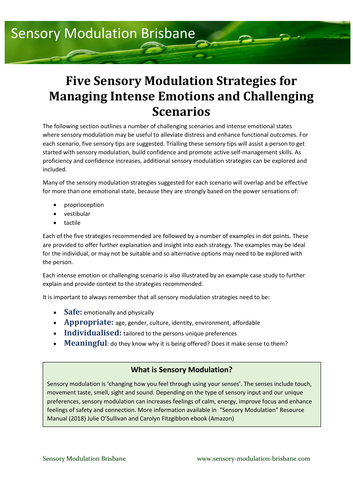
Change How You Feel Series
Sensory Modulation Strategies for Managing Intense Emotions
and Challenging Scenarios
Teachers are increasingly called on to support students who are in distress. Having a range of strategies, effective for both children and teachers, to reduce stress and increase feelings of safety and calm can enhance teacher and student emotional health and wellbeing, resilience and confidence.
Sensory modulation changes how you feel through using your senses (such as sight, sound, smell, taste, touch and movement). It changes the physiology of the body, and in doing so creates a positive shift in feelings. Research shows that body based interventions, like sensory modulation, target the brain centres that control the stress response and are thus more effective for people in emotional distress, who have experienced trauma, or have developmental or learning difficulties.
Sensory modulation helps children, teenagers and adults to:
• feel more grounded when spacey, zoned out or having difficulty focusing
• self soothe when feeling self-hatred, shame, sadness or coping with loss
• calm down when feeling anxious, scared, angry or restless
• relax when feeling physically uptight or mentally stressed
• feel more energised and focused when tired, lethargic, or having trouble concentrating
• increase feelings of safety and security when afraid or troubled by distressing worries or memories
• self-manage pain or inability to sleep
• increase positive feelings in the moment when feeling sad or worried
• use alternatives to acting out or hurting themselves when extremely distressed
The following worksheets recommend sensory modulation strategies to help teachers and students in particular situations. Strategies identified focus on the power sensations, which are considered the most effective and thus useful for multiple scenarios. As skills and confidence increase with use, additional sensory strategies can be explored and included, which will further enhance effectiveness and personal self-mastery.
The ‘Change How You Feel Series’ includes:
Change how you feel: panic, anxiety and stress
Change how you feel: grounding
Change how you feel: anger and agitation
Change how you feel: enhance feelings of safety
Change how you feel: difficulty sleeping
Change how you feel: feeling numb
Change how you feel: cigarette cravings
Change how you feel: cravings for substances
Change how you feel: self-harm
Change how you feel: pain
Change how you feel: auditory hallucinations (A.H)
Change how you feel: for people with dementia
Change how you feel: waiting room design
The Change how you feel series are available in PDF at the TES shop – www.tes.com (search for ‘Change how you feel’ series). They are also available with other useful teaching resources as part of the Sensory Modulation Resource Manual, an e-book also available at the TES shop.
Something went wrong, please try again later.
This resource hasn't been reviewed yet
To ensure quality for our reviews, only customers who have purchased this resource can review it
Report this resourceto let us know if it violates our terms and conditions.
Our customer service team will review your report and will be in touch.
